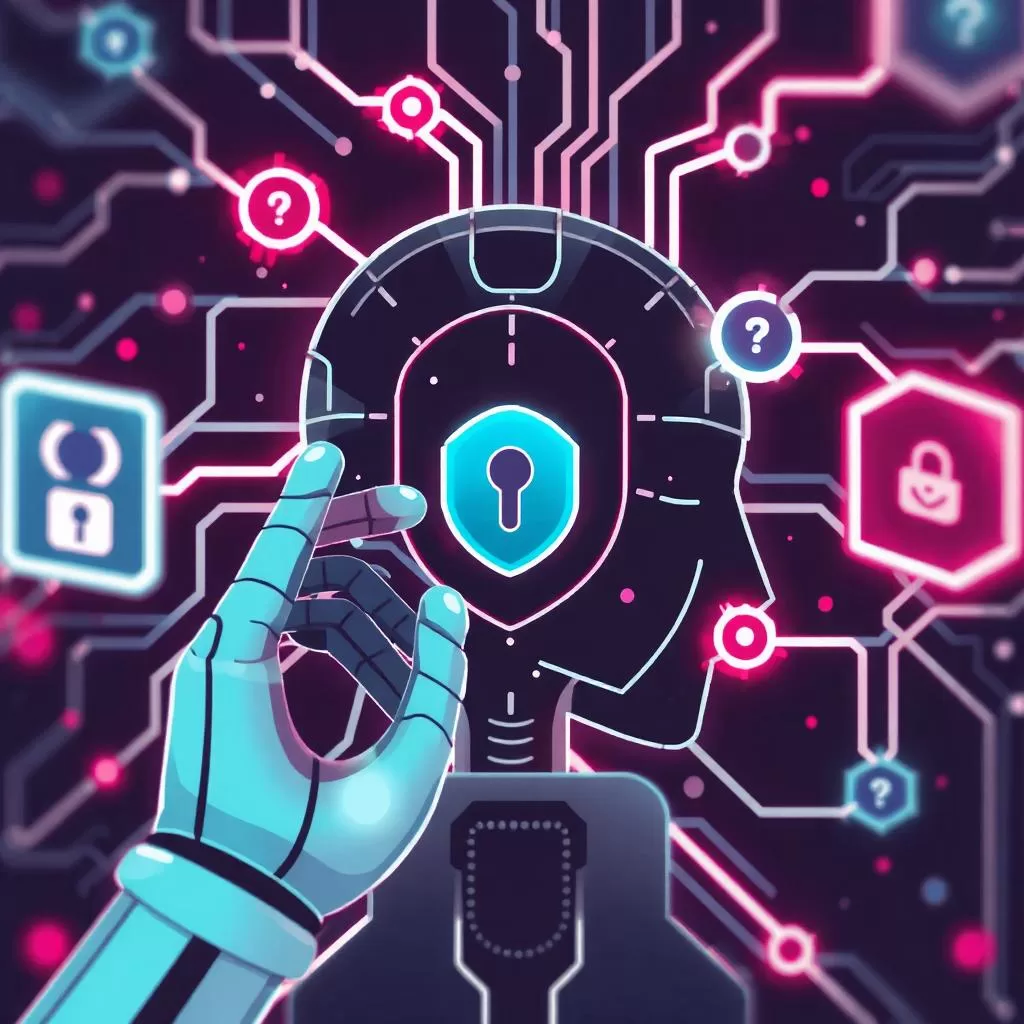Cybersecurity Threats in 2025 and How to Protect Yourself
As technology advances, so do cybersecurity threats. Hackers are now using AI, deepfakes, and advanced malware to carry out sophisticated attacks on individuals, businesses, and even governments. In 2025, cyber threats will become more dangerous and harder to detect, making proactive cybersecurity strategies essential for online safety.
What You’ll Learn in This Article about Cybersecurity Threats:
- The biggest cybersecurity threats to watch for in 2025
- How AI, phishing, ransomware, and IoT vulnerabilities are evolving
- Best cybersecurity practices to stay protected
AI-Powered Cyber Attacks: A key Cybersecurity threat
Artificial Intelligence (AI) is being weaponized by cybercriminals to automate attacks, making them more efficient and harder to detect.
How Hackers Use AI in Cyber Attacks:
✔ AI-Generated Phishing Emails
First, cybercriminals use AI to create phishing emails that are nearly indistinguishable from legitimate ones. These emails mimic company branding, writing styles, and even tone, making it much harder for users to identify them as fraudulent. As a result, recipients are more likely to click malicious links, download malware, or disclose sensitive information.
✔ Deepfake Technology for Scams
In addition, AI-powered deepfakes are making scams more convincing. Hackers can now impersonate trusted individuals, such as CEOs, co-workers, or even family members, through audio and video messages. This enhanced level of deception enables hackers to manipulate victims into approving fraudulent transactions, disclosing login details, or even granting unauthorized access to secure systems.
✔ AI-Driven Password Cracking
Moreover, AI is transforming password cracking. Hackers now deploy AI algorithms that can test millions of password combinations in a matter of seconds. These intelligent tools can easily bypass weak or reused passwords, gaining access to email accounts, banking information, or even corporate systems. Consequently, without proper multi-factor authentication, even slightly secure passwords can be cracked by AI.
💡 For example, in 2023, a deepfake scam used AI-generated voices to trick a company into wiring $35 million to hackers.
🔗 Related: How AI is Transforming Cybersecurity
Ransomware 2.0: Double & Triple Extortion
Ransomware attacks are evolving beyond simple data encryption. Hackers now steal sensitive data and threaten to leak it unless the victim pays a ransom.
The Evolution of Ransomware Attacks:
✔ Double Extortion
To start, modern ransomware doesn’t just lock files—it also steals sensitive data before encryption.
Hackers then demand payment not only to restore access but also to prevent public leaks of the stolen information.
This added leverage makes victims more likely to pay quickly.
✔ Triple Extortion
Taking it further, attackers are now targeting third parties connected to the initial victim.
This could include customers, vendors, or partners, who are pressured to pay ransoms as well.
As a result, a single attack can affect multiple organizations, amplifying the financial and reputational damage.
✔ AI-Powered Ransomware
Finally, AI is enabling ransomware to spread faster and smarter.
It can identify vulnerable systems, escalate privileges, and move laterally across networks within minutes.
Consequently, traditional defenses often don’t react fast enough, leaving businesses more exposed than ever.
Bottom line: Understanding the evolving nature of ransomware is key to building stronger, AI-powered defenses that can stop threats before they escalate.
💡 For example, the Colonial Pipeline ransomware attack led to fuel shortages in the U.S. after hackers shut down operations.
IoT Security Risks: Smart Devices as a Target
The rise of Internet of Things (IoT) devices—smart home gadgets, connected cars, and wearable tech—has created new security vulnerabilities.
How IoT Devices Are Being Hacked:
✔ Weak Security Settings in Smart Devices
To begin with, many smart devices still come with default usernames and passwords that users forget to change. Hackers easily scan networks for these unsecured devices and gain access with minimal effort. Unfortunately, once one device is compromised, it can serve as a gateway to the entire network.
✔ Botnets Like Mirai
In addition, cybercriminals often use botnets—networks of hacked devices—to launch massive attacks.
For example, the Mirai botnet took control of millions of IoT devices and used them to launch distributed denial-of-service (DDoS) attacks that crippled major websites. Today’s botnets are even more powerful, and they grow by infecting vulnerable IoT gadgets across homes and industries.
✔ AI-Powered Malware as a source of key Cybersecurity threats
Furthermore, AI is now being used to supercharge malware that targets IoT systems.
This malware can scan for weaknesses, learn device behavior, and spread autonomously across networks—infecting smart thermostats, cameras, appliances, and even medical or industrial equipment. As a result, smart homes and factories face a new wave of intelligent, rapidly evolving cyber threats.
Pro Tip: Always change default credentials, update firmware regularly, and segment your network to prevent full-system compromise from a single weak device.
💡 For example, the Mirai botnet attack in 2016 hijacked IoT devices and caused major internet outages worldwide.
🔗 Related: The Role of AI in Mobile App Development
Deepfake Scams & Social Engineering
Deepfake technology uses AI to create fake videos, voice recordings, and images to impersonate real people.
How Deepfakes Are Used in Cybercrime:
✔ Fake CEO Video Calls for Fraudulent Transactions
To start, cybercriminals are using deepfake video calls to impersonate high-ranking executives.
For instance, they might create a realistic video of a CEO instructing a finance team member to authorize a wire transfer or approve a large payment.
Because the deepfake appears convincing and urgent, employees often comply before realizing it was a scam.
✔ AI-Powered Voice Cloning for Money Scams
Additionally, voice cloning software now allows hackers to replicate someone’s voice with just a short audio clip. They use this technology to call employees, family members, or partners, pretending to be someone the victim trusts. As a result, people are being manipulated into transferring funds or disclosing sensitive information.
✔ Deepfake Political Propaganda
Furthermore, deepfakes are being used to spread misinformation and disrupt political discourse.
Cybercriminals and bad actors can fabricate videos of public figures saying things they never said, which are then shared on social media to sway public opinion or incite conflict.
This type of cyber manipulation poses a serious threat to democracy and social stability.
Bottom line: Deepfakes blur the line between truth and fiction. As they become more convincing, it’s crucial to combine AI-powered detection tools with public awareness to stay protected.
💡 For example, in 2022, hackers used a deepfake video of Ukrainian President Zelensky to spread false military orders.
Cloud Cybersecurity Threats and Vulnerabilities
As businesses move to cloud-based storage, cybercriminals are targeting misconfigured cloud databases to steal sensitive information.
Cloud Security Threats
✔ Data Breaches from Poorly Secured Cloud Storage
To begin with, improperly configured cloud storage is one of the most common threats.
When users fail to manage security settings properly, attackers can expose sensitive data—such as customer information or intellectual property—to the public. As a result, attackers can easily access and steal critical data without even having to breach the network.
✔ Malware-Infected Cloud Applications
Additionally, cloud apps can become entry points for malware if not properly vetted or monitored.
For example, a single infected file uploaded to a shared cloud platform can spread malware across an entire organization.
This makes cloud environments highly vulnerable to rapid, large-scale infections—especially in collaborative workspaces.
✔ Unauthorized Access Due to Weak Identity Verification
Furthermore, many breaches occur because of inadequate authentication protocols.
Without multi-factor authentication or strong password policies, it’s easier for hackers to gain access through stolen credentials or brute-force attacks.
In turn, this can lead to full control over cloud accounts and significant data loss or manipulation.
Pro Tip: Regularly audit your cloud configurations, enable MFA, and use AI-powered monitoring tools to detect threats before they escalate.
💡 For example, in 2023, over 1 billion email records were leaked from an unsecured cloud database.
🔗 Related: Top 10 Emerging Technologies in 2025
Cybersecurity threats related to 5G Network Security Risks
The global rollout of 5G networks is increasing cybersecurity challenges due to faster data speeds and billions of connected devices.
Cybersecurity Threats in 5G Networks:
✔ More IoT Vulnerabilities from Increased Connectivity
To start with, 5G supports massive numbers of connected devices, from smart home gadgets to industrial sensors.
This surge in connectivity significantly expands the attack surface, giving hackers more opportunities to exploit weak or unpatched IoT devices.
Without robust IoT security, even a single compromised device can serve as a gateway into an entire network.
✔ Faster Malware Distribution Across Networks
Moreover, 5G’s high-speed data transfer can work against us in cybersecurity.
With data moving faster than ever, malware can spread at lightning speed—infecting multiple devices or systems in seconds.
This makes real-time detection and response tools essential to prevent widespread damage.
✔ Increased Risk of Cyber Espionage in Smart Cities
Furthermore, as 5G powers smart infrastructure—like traffic control systems, surveillance networks, and utilities—it also becomes a target for cyber espionage. State-sponsored attackers and cybercriminals may attempt to intercept sensitive data or disrupt critical city services. In this context, national security and public safety are at higher risk than ever before.
Pro Tip: Organizations adopting 5G should integrate AI-based monitoring, enforce strict IoT standards, and regularly update firmware to reduce vulnerabilities.
💡 Example: Hackers could exploit 5G-connected autonomous vehicles, posing security risks.
Cybersecurity threats related to Zero-Day Exploits & Advanced Persistent Threats (APTs)
Zero-day vulnerabilities are unknown software bugs that cybercriminals exploit before companies can release a security patch.
How Zero-Day Exploits Work as cybersecurity threats:
Zero-day exploits are among the most dangerous tools in a hacker’s arsenal. Hackers exploit these vulnerabilities, known as “zero-day,” because software vendors have not discovered them, and no official fix or patch is available—leaving systems dangerously exposed.
✔ Hackers Sell Zero-Day Vulnerabilities on the Dark Web
To begin with, once hackers discover a zero-day vulnerability, they often choose to profit from it rather than report it. These exploits are sold on the dark web, sometimes for hundreds of thousands of dollars, depending on the software and its potential targets. Consequently, cybercriminals or nation-state actors can purchase these flaws to launch stealthy and devastating attacks.
✔ APTs Use Zero-Days to Hack Critical Infrastructure
Furthermore, advanced persistent threat (APT) groups—often backed by governments—use zero-day exploits to target high-value systems.
These can include power grids, water treatment facilities, communication networks, or even financial institutions.
By remaining undetected for long periods, these attacks can quietly extract sensitive data or sabotage critical services.
✔ AI is Now Detecting Flaws Faster Than Humans
On a more hopeful note, artificial intelligence is being deployed to scan software code and system behavior for hidden flaws. Unlike traditional methods, AI can identify unusual patterns or unknown vulnerabilities much faster than human researchers. As a result, organizations are beginning to close the gap between discovery and defense before attackers can exploit these weaknesses.
Bottom Line: Zero-day threats are evolving rapidly, but so are the tools to defend against them. Proactive security measures, AI-powered detection, and responsible disclosure are more important than ever in the fight against these hidden dangers.
💡 For example, the Microsoft Exchange Server zero-day attack in 2021 exposed thousands of businesses to cyber threats.
Biometric Security Breaches: One of the key Cybersecurity threats
Biometric authentication—like fingerprint scans and facial recognition—is not foolproof and is being bypassed using AI-based attacks.
Cybersecurity Threats based on Biometrics:
✔ AI-Generated Synthetic Fingerprints Can Trick Scanners
To start with, hackers are using AI to generate synthetic fingerprints that closely mimic real ones. Attackers can 3D print or encode these digitally created fingerprints to deceive biometric scanners—particularly those on mobile devices or unsecured access points.
As a result, attackers may gain unauthorized access to sensitive systems or accounts without raising suspicion.
✔ Deepfake Face-Swaps Bypass Facial Recognition
In addition, deepfake technology has advanced to the point where it can replicate facial movements and expressions in real time.
This allows cybercriminals to create face-swap videos that can trick facial recognition systems used in banking apps, border control, or secure facilities. Ultimately, attackers exploit the illusion of identity to commit fraud, impersonate individuals, or conduct espionage.
✔ Biometric Databases Are Being Hacked and Leaked
Most concerningly, centralized databases containing biometric data are becoming prime targets for cybercriminals. When hackers breach these databases, they steal biometric data—such as fingerprints, face maps, or retina scans—that can’t be changed like a password. This creates a long-term security risk for victims, as attackers can reuse biometric information in future attacks.
Pro Tip: Businesses should implement multi-layered security by combining biometric verification with AI-driven behavior monitoring and encryption to minimize risk.
💡 For example, researchers successfully tricked Apple’s Face ID using AI-generated 3D masks.
Phishing & Business Email Compromise (BEC) Scams
Phishing attacks remain one of the biggest cybersecurity threats, with hackers using AI to generate convincing fake emails.
Types of Phishing Attacks and Cybersecurity Threats:
✔ Spear Phishing – Highly Targeted Scams being a source of top Cybersecurity threats
To begin with, spear phishing focuses on specific individuals, such as company executives or employees with access to sensitive systems.
Hackers research their targets to craft convincing emails that appear legitimate—often impersonating a CEO or trusted vendor.
As a result, victims are more likely to click malicious links, transfer funds, or share confidential data.
✔ Fake Login Pages – Designed to Steal Credentials
Next, attackers create fake websites that look identical to real login pages—for services like Microsoft 365, PayPal, or banking platforms. These pages trick users into entering their usernames and passwords, and attackers capture the information directly.
Consequently, even cautious users may unknowingly compromise their accounts.
✔ AI-Powered Phishing Emails – Mimicking Real Companies
Moreover, cybercriminals now use AI to generate phishing emails that mirror the tone, style, and formatting of actual businesses.
For example, in 2023, AI-generated phishing messages mimicking well-known brands like Amazon and Google led to a significant spike in successful phishing attacks.
This trend continues in 2025, making it harder than ever to distinguish fake from real.
💡 For example, in 2023, AI-generated phishing emails increased scam success rates by over 30%.
Cryptojacking & Blockchain Cybersecurity Threats as Security Risks
Cybercriminals are exploiting blockchain and cryptocurrency platforms through cryptojacking, fraud, and wallet hacks.
Phishing attacks have become more advanced than ever—especially with the growing use of artificial intelligence. In 2025, AI-powered phishing attacks are evolving rapidly, targeting both individuals and organizations through increasingly convincing digital traps. Below are the most common forms:
✔ Spear Phishing – Highly Targeted Scams
To begin with, spear phishing targets specific individuals—typically executives, administrators, or employees with elevated access. Cybercriminals research their victims on social media and business platforms to craft personalized, believable emails. As a result, users are more likely to click malicious links, transfer funds, or unknowingly expose sensitive data.
✔ Fake Login Pages – Designed to Steal Credentials
Next, attackers set up fake websites that look nearly identical to real login portals—for platforms like Microsoft 365, PayPal, or corporate intranets. These deceptive sites lure users into entering usernames and passwords, which attackers capture and exploit. Consequently, even well-trained employees can fall for these traps, leading to major data breaches.
✔ AI-Powered Phishing Emails – Mimicking Real Companies
Moreover, cybercriminals now use AI to write emails that replicate the language, design, and tone of trusted brands. For instance, in 2023, a wave of AI-generated phishing emails mimicking companies like Amazon, Google, and Netflix resulted in record-breaking phishing success rates.
💡 Pro Tip: Always inspect sender addresses, hover over links before clicking, and enable multi-factor authentication (MFA) to stay protected from phishing attacks.
How to Protect Yourself from Cybersecurity Threats in 2025
- Use AI-Powered Cybersecurity Tools – AI can detect and block threats faster.
- Enable Multi-Factor Authentication (MFA) – Adds an extra layer of security.
- Update Software Regularly – Zero-day vulnerabilities are patched frequently.
- Avoid Clicking Suspicious Links – Phishing scams rely on social engineering.
- Secure IoT Devices – Change default passwords and update firmware.
Conclusion: Cybersecurity Threats in 2025 Requires Proactive Protection
As cyber threats become more advanced, staying informed and proactive is the best defense. Businesses and individuals must adopt AI-driven security solutions, strengthen password policies, and be vigilant against phishing & deepfake scams.
Key Takeaways regarding Cybersecurity threats:
- AI is being used for both cyberattacks and cybersecurity defense.
- Ransomware, phishing, and deepfake scams are on the rise.
- Protect yourself with strong passwords, MFA, and AI-driven security tools.
💬 Which cybersecurity threats concern you the most? Share your thoughts in the comments!
Share this content:







Post Comment